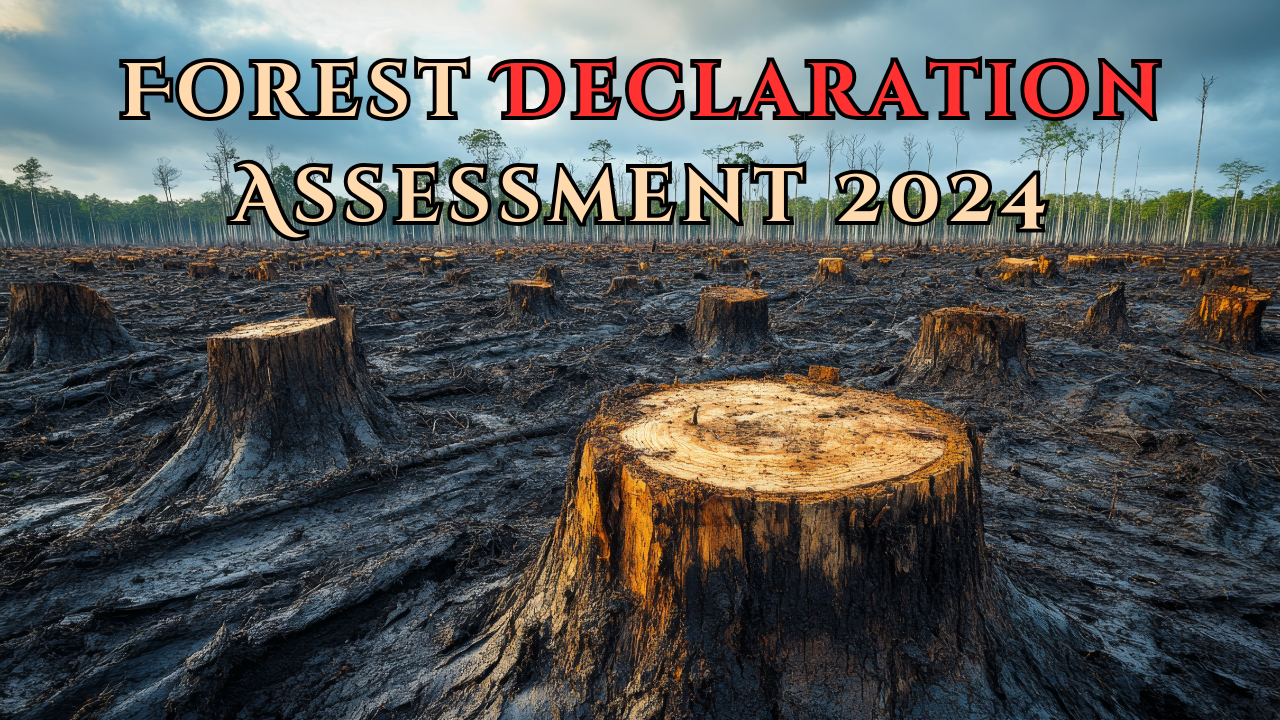Forest Declaration Assessment 2024
Context:
The Forest Declaration Assessment 2024 reveals a sharp increase in global deforestation rates, serving as an urgent call for world leaders to take decisive action on forest conservation.
Key Findings of the Report:
- High Global Deforestation : In 2023, the world lost 6.37 million hectares of forest, far off track from global deforestation reduction goals, with forest loss increasing by 45% compared to targets set for 2030.
- Primary Forest Loss: Essential tropical forests, critical for carbon storage and biodiversity, lost 3.7 million hectares. Efforts are 38% behind global goals for protecting these regions.
- Forest Degradation: Over 62.6 million hectares of forest were damaged in 2022, 10 times worse than deforestation alone.This degradation particularly threatens forests in developed countries, raising concerns about their ability to support essential ecosystem functions.
- Loss of Key Biodiversity Areas:TThe report highlights the loss of over 1.4 million hectares of forest in Key Biodiversity Areas (KBAs) in 2023, crucial for wildlife and Indigenous communities.
- Impact of Forest Fires: Forest fires, driven largely by land clearing for agriculture, have destroyed 138 million hectares of tree cover since 2001, with a third of that loss occurring between 2019 and 2023.
Other Key Inference:
- Indigenous Communities are Vital for Forest Conservation:Their involvement is critical to reversing deforestation trends, and their rights need to be safeguarded as part of broader conservation efforts.
- Policy and Economic Shifts Can Reverse Progress:The report notes that while strong regulations and laws can reduce deforestation (as seen in Brazil), political and economic changes can easily reverse these gains, showing the need for consistent and long-term commitment to forest protection policies.
Global Trends:
- Brazil: Made progress, with a 62.2% reduction in deforestation in the Amazon, reflecting a 9% reduction in deforestation overall.
- Indonesia: Deforestation surged by 57%, driven by nickel demand for EV batteries.
- Bolivia: Agriculture expansion drove deforestation, making the country 98% off track.
Reasons for High Deforestation:
- Nickel Demand Fuels Deforestation:The rising demand for nickel, essential for electric vehicle batteries, has intensified deforestation, with Indonesia producing half of the world’s supply last year and expected to reach 80% by 2040.
- Forest Degradation and Agricultural Expansion: Logging, fires, and land clearing—especially for agriculture and commodities like soy and palm oil—continue to degrade forests, with tropical forests making up 96% of global deforestation.
- Bolivia: Agricultural commodities like soy and beef contributed to 98% of the country’s deforestation, reflecting the global demand for these products.
- Political and Economic Shifts Impact Forest Protection:The report emphasises that changes in political and economic landscapes can undermine forest protection efforts. Erin Matson from Climate Focus pointed out that, despite strong laws, progress can be reversed by these shifts.
Recommendations to Reduce Deforestation:
- Ensuring Adequate Funding
- Reducing Demand for Deforestation-Linked Products
- Recognising Indigenous and Local Community Roles
- Scaling Up Restoration and Fire Management
The 2024 Forest Declaration Assessment report, titled “Forests under fire: Tracking progress on 2030 forest goals,” provides a comprehensive evaluation of global efforts to halt deforestation and restore degraded forests. This annual assessment, produced by a coalition of research and civil society organizations, tracks progress towards the ambitious goals set by international commitments such as the New York Declaration on Forests (2014) and the Glasgow Leaders’ Declaration on Forests and Land Use (2021)
Conclusion:
The report stresses the urgent need for action to protect global biodiversity and climate stability. It warns that deforestation and forest fires, particularly in tropical regions where 96% of deforestation occurred in 2023, are threatening vital ecosystems. The authors call for immediate efforts to conserve existing forests, curb overconsumption, restore degraded environments, and enhance fire management strategies.
Subscribe to our Youtube Channel for more Valuable Content – TheStudyias
Download the App to Subscribe to our Courses – Thestudyias
The Source’s Authority and Ownership of the Article is Claimed By THE STUDY IAS BY MANIKANT SINGH





